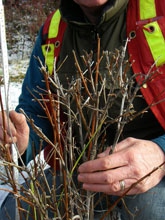Bedload is a term used to describe particles in a stream that are being carried or transported along the streambed.
Browse Utilization
Is a measurement of the amount of the current year’s annual growth that has been consumed by livestock. By regulation, the Forest and Range Practices Act sets the maximum browse utilization by livestock at 25%, with the intent of providing sufficient browse for wildlife and also to ensure plant vigour during critical periods. The district manager may choose to set browse utilization standards that are lower than prescribed by regulation.
Business Planning
The act of applying long range strategic directions of an organization toward the development of shorter-term (generally annual), work plans, budgets and associated resource allocation.
Browse
 That part of leaf and twig growth of shrubs, woody vines, and trees available for animal consumption, or, the act of consuming browse (browsing).
That part of leaf and twig growth of shrubs, woody vines, and trees available for animal consumption, or, the act of consuming browse (browsing).
Broadcast Burning
A controlled burn, where the fire is intentionally ignited and allowed to proceed over a cutblock within well‐defined boundaries, for the purpose of reducing fuel hazard after logging, or for site preparation before planting.
Bog
A class of wetland characterized by a thick layer of sphagnum-based peat. It receives its water primarily from direct precipitation. Bog waters tend to be acidic and nutrient-poor.
Blue List Species
Species of special concern (formerly called “vulnerable”) in British Columbia. These species are not immediately threatened, but are of concern because of characteristics that make them particularly sensitive to human activities or natural events.
Blowdown (Windthrow)
Uprooting by the wind. Also refers to a tree or trees so uprooted.
Biological Control
The use of living organisms, such as predators, parasitoids and pathogens, to control invasive plants.
Biogeoclimatic Zone
A geographic area having similar patterns of energy flow, vegetation and soils, as a result of a broadly homogenous macroclimate.

